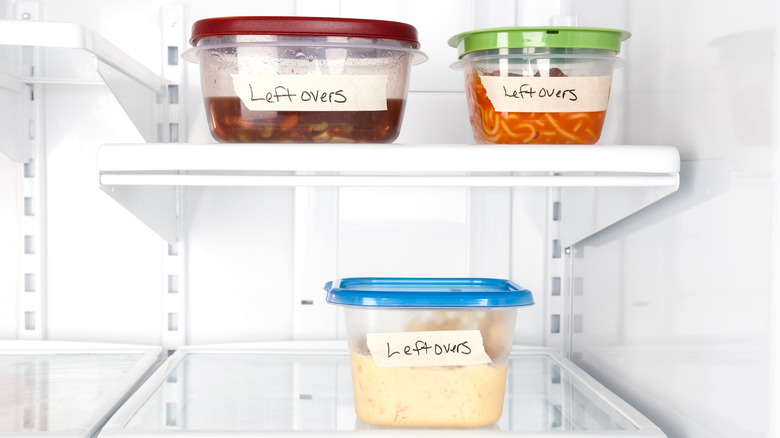The Rule You Need To Remember For Returning Leftovers To The Fridge
Leftovers can be a godsend, especially when it's a work night, and cooking an entire meal from scratch is the last thing you want to do. According to MarthaStewart.com, 46% of people actually enjoy eating leftovers, and 79% consider soup to be the perfect leftover meal.
Whether you enjoy eating leftovers or not, finishing every last bite can save you a great deal of money — possibly up to $1,000 a year (per Money Under 30). Naturally, you'll continue to microwave it night after night, even if you can't stand eating it any longer.
Heating up leftovers can be tricky for a few reasons. You might be left wondering how long you can keep your leftovers or how many times you can continue to reheat leftovers. All of these questions are valid, but one rule trumps all: How long you can leave your leftovers sitting out at room temperature before returning them to the fridge?
How long can you leave leftovers sitting out?
We've all accidentally forgotten about a meal on the counter before remembering to put it away, but does it really impact the longevity of leftovers themselves? Can't you just put it back in the fridge and eat it again tomorrow? You may be surprised to know the truth behind how long leftovers can safely sit out.
If not careful, eating leftovers that have sat at room temperature for too long could cost you a sick day at work. Food Network says that leaving leftovers out on the counter for two hours or more runs the risk of it harboring foodborne illnesses. What's more, if the room temperature is 90 degrees Fahrenheit or higher, you may have even less time (about an hour) before bacteria grows, making the food unsafe to eat.
The general rule of thumb? Throw away any leftover food that's been sitting out for more than two hours at room temperature. Your best bet is to scoop whatever leftovers you want and immediately return them to the fridge to be on the safe side.
More tips on safely eating leftovers
As long as you put your leftover pizza in the fridge (or freezer) within two hours of it sitting on the counter, you can safely enjoy it again (via Los Angeles Times). Generally, though, resorting to the "sniff test" and consuming your leftovers without a general timeframe may be a gamble since certain foods are at a higher risk for developing bacteria, which could cause food poisoning.
According to Total Knife Care, there are high, medium, and low-risk foods when it comes to leftovers. Some high-risk leftovers that you'll want to be more careful of are rice and seafood, both of which should be eaten within three days, and meat which you'll want to consume within four days. Soups and stews are also considered high-risk and should be eaten within three to four days.
Medium-risk foods include cooked pasta and other grains, which should be eaten within three days, and desserts and puddings which you should toss after four days.
Low-risk foods that will stay fresher for longer are fresh fruit and vegetables, which should generally be eaten within a five-day window. Bread is also a low-risk food that can last longer at room temperature, so long as there isn't any mold.
Next time you're plating your leftovers, keep these tips in mind so you can safely enjoy every last bite of your favorite meal. Plus, save time, money, and a potential sick day in the process!


